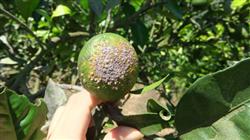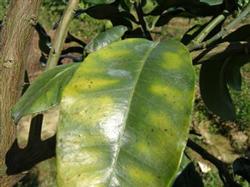Heat damage of Citrus and its Prevention Technology

Citrus is a tropical and subtropical evergreen fruit tree (except trifoliate orange). It is warm and humid, but it is also afraid of heat. If the abnormal high temperature weather of 30 ℃ or more occurs during the period from flowering to stable fruit of citrus, it will affect its normal flowering and fruiting, and the earlier the occurrence time, the greater the damage caused by high temperature. During this period, the abnormal drop of flowers and fruits caused by high temperature weather, resulting in yield loss, is called citrus heat damage. 1. The cause of abnormal fruit drop caused by heat damage 1. The situation of abnormal fruit drop is different between variety lines and different varieties and strains. The fruit setting rates of Miyagawa Wenzhou mandarin, Weizhang Wenzhou mandarin, Nanfeng mandarin, mandarin and Zhangtou red, which are both 9 years old, are 0, 0.8%, 4.1%, 4.8% and 5.3%, respectively. It can be seen that the fruit drop of seedless varieties is more serious than that of seedless varieties, and that of Wenzhou mandarin early-maturing varieties is more serious than that of mid-late maturing varieties. two。 The 6 -, 7-and 8-year-old trees of Wenzhou mandarin were investigated, and the fruit setting rates were 0%, 0.8% and 1.1%, respectively, indicating that the younger the tree is, the more serious the fruit drop is. At the same time, after the investigation of 9-year-old trees, it is found that the fruit drop is more serious when the tree is strong, the spring shoot is strong or weak, the amount of flowers is large, and the fruit drop is more serious when the spring shoot is not or less, while the fruit drop is lighter when the tree is moderate and the spring shoot is medium. 3. Types of fruit branches and abnormal fruit drop under normal circumstances, the fruit setting rate of leafy fruit branches, especially long leafy fruit branches, is higher, while that of leafless fruit branches is lower, but in abnormal high temperature weather, leafless degenerated branches set more fruit (accounting for 91% of the total number of fruits), short leafy fruit branches set less fruit (9%), and all fruits of leafy long fruit branches fall off. 4. The fruit setting position and abnormal fruit drop tree crown, the external fruit drop is serious (almost light), while the lower part and inner bore fruit setting more. 5. Fertilization spraying hormone and abnormal fruit drop in winter, the application of base fertilizer was delayed to the end of December, and the spring fertilizer was too heavy, which led to a large number of spring shoots, aggravated the contradiction of top fruit and aggravated fruit drop; when the high temperature weather in flowering stage came, no measures were taken to protect flowers and fruit, which aggravated the abnormal fruit drop. 6. Winter defoliation and abnormal fruit drop serious defoliation in winter, resulting in tree potential decline, affecting flower bud differentiation and flower quality, abnormal flower drop is serious. 7. Timely irrigation and abnormal fruit drop the tree which can be irrigated in time under high temperature and drought has a higher fruit setting rate. During the period of high temperature in May, three strains of Wenzhou mandarin were irrigated with 40 kg, 80 kg and 120 kg pig urine respectively, the results showed that the fruit setting rate of 120 kg was the highest, and the plant yield was 40 kg, while that of 80 kg was in the middle, and that of 40 kg was the lowest, and the plant yield was 10 kg. 8. Citrus producing area and abnormal fruit drop in China, the heat damage of citrus caused abnormal fruit drop, especially in the citrus producing areas in the middle and lower reaches of the Yangtze River, especially in the early May at the turn of spring and summer. At present, the high temperature early warning signals issued by Chinese meteorological stations are divided into three levels, which are indicated by yellow, orange and red respectively, indicating that the 24-hour maximum temperature will rise to more than 36 ℃, 37 ℃ and 39 ℃ respectively. Citrus growers should pay attention to the high temperature forecast of the meteorological station, issue early warning for the coming high temperature, and take corresponding preventive measures to reduce the occurrence of citrus heat damage. Third, heat damage prevention 1. In the selection of citrus orchard site, the effect of high temperature should be considered as a main factor and heat-avoiding cultivation should be carried out as far as possible. Such as selecting suitable places for local microclimate in the large climate environment, setting up conservation forests, improving the ecological environment, and so on, cultivation in rivers and riversides can also reduce heat damage. two。 Varieties with strong heat resistance and rootstocks should be selected, such as Wenzhou mandarin mandarin late-maturing varieties and sweet orange varieties with seeds. 3. The citrus planted on the deep, loose and fertile soil has strong heat resistance; on the contrary, the heat resistance of the citrus planted on the barren soil is poor. 4. Strengthening cultivation management and strengthening cultivation management can reduce the heat damage of citrus, mainly including the following aspects of management: ① soil management. The most important thing is to deepen the soil layer and increase the content of soil organic matter, and it can also cover the trees that are put into production when the temperature is higher than 30 ℃. The implementation of grass cultivation in the whole garden from March to September is also beneficial to reduce the heat damage. ② fertilizer management. First, re-apply budding fertilizer, when spring buds begin to sprout in early March, re-apply fertilizers based on available nitrogen fertilizer to meet the needs of tree shoot sprouting, flowering and fruit setting. The second is to increase the application of phosphorus and potassium fertilizer, which is often sprayed on the leaf surface in spring, which plays an obvious role in preventing heat damage and reducing abnormal fruit drop. ③ water management. Timely irrigation and keeping the soil moist can reduce the heat damage, and the effect of spraying water is better than that of irrigation. ④ branch management. First, protect the overwintering leaves. Put the autumn shoots and apply urea or dilute dung water properly after fruit harvest to strengthen the tree potential and protect the leaves; it can also be sprayed with a concentration of 10 mg / kg 2penny 4murD solution to keep the leaves through the winter. The second is to re-apply spring shoots to reduce the number of new leaves. Spring shoots should be wiped early, re-wiped, and wiped more: early wiping starts from the emergence of buds; re-wiping, that is, according to the proportion of new and old leaves, erase redundant spring shoots, and then use early summer shoots to make up for the lack of tree leaves. Multiple wiping means wiping the top several times in batches, usually once every 7 to 10 days, until the end of the second physiological fruit drop, and it can also erase all late spring and early summer shoots after the end of flowering, erase 30% to 50% of spring shoots before flowering, and leave 3% to 5 leaves for the remaining spring shoots. ⑤ pest control. Do a good job in the prevention and control of bud maggots, mites, leaf beetles and anthracnose to protect leaves and fruits. 5. Emergency measures ① spray flower and fruit preservative. Use synergistic liquefied cytokinin (BA) + gibberellin (GA) or synergistic liquefied gibberellin + gibberellin (sprayed type). Add 0.5 kg of water to each bottle (10 ml) (0.6 kg of water for adult oranges, 0.75 kg of water for young trees, 0.75 kg of water for young trees and 0.75 kg of water for Wenzhou mandarin) to form a diluent. In 5-10 days after citrus blossom, apply the whole fruit surface with a brush dipped in a dilution solution and moist it. Generally, you can apply the fruit once to have enough fruit. For some plants whose growth is weak or vegetative growth is too prosperous and easy to drop fruit, it can be applied again at the beginning of the second physiological drop. Spray type each bottle (10 ml) add water 10: 15 kg to mix well, mix into a diluent, when the citrus is 70% 80% blossom, spray the crown young fruit with a sprayer, mainly spray the fruit, and spray as little as possible on the leaves and shoots. Spray again 10-25 days after the first spray, for varieties or plants that are very easy to drop fruit, spray the third time in 30-40 days after flowering, rain within 12 hours after spraying, and spray once when the weather is fine. The effect of using micro sprayer (using mosquito repellent or other micro sprayer to spray quasi-flowers and young fruits) is better. The miniature sprayer adds about 5 kilograms of water to each bottle. Pomelo should be tested in a small area before spraying to ensure safety. Wenzhou mandarin can also choose its special fruit protectant-Baoganling. Usage: add 50% 70% alcohol or 25g spirit to each packet of Baotang Ling powder, stir and dissolve, add 25kg water to spray the crown, spray it for the first time at the end of blooming, re-spray it once after 15-25 days, mainly spray flowers and fruits, and moist. In addition, gibberellin 10 mg / kg + 0.4% potassium dihydrogen phosphate + 0.1% borax solution can also be sprayed at the flower bud stage; within 15 days after flowering, gibberellin 30 mg / kg + cytokinin 800 times solution can be sprayed; when the second physiological fruit drop is sprayed, 10 mg / kg 2L4LFD + Lubao 800 times solution is sprayed to prevent abnormal fruit drop of Wenzhou mandarin. Paclobutrazol can also be used to protect fruit. When the spring shoot is 1.5 cm long, spray the growth inhibitor paclobutrazol (the late effect is not ideal), spray it again after 7 days and 10 days. ② ring peeling ring cutting. From the early flowering stage to the end of full bloom, the big branches of the early fruiting trees or prosperous trees were cut or peeled around. ③ sprays fungicides. Spraying topiramate and other fungicides before rain to prevent mold infection, timely shaking of residual flowers and raindrops after rain also has a certain effect on fruit protection.
- Prev

Planting method of Snake skin Fruit
Planting method of Snake skin Fruit
- Next

Prevention and treatment of magnesium deficiency in Citrus
In recent years, due to the transfer of a large number of rural labor force to cities and towns, the amount of livestock raised by farmers is decreasing, and the source of organic fertilizer is significantly reduced. Coupled with the depressed fruit prices for many years, the amount of organic fertilizer used by fruit farmers in fruit production has been greatly reduced, or even not used. As a result, the phenomenon of element deficiency in orchards has been increasing in recent years. Especially the medium element magnesium.
Related
- Moge, come on! The staff of the peasant association in the producing area of cantaloupe were frightened when the crowd gathered.
- Causes and Solutions of low Fruit setting rate of Apple
- Symptoms and control measures of passion fruit virus disease
- Fruit growing lesson: how do apple orchards keep high yields?
- Can you build orchards in the mountains? What are the pros and cons?
- How to manage the coloring period of Crisson grape?
- This paper introduces the processing technology of two kinds of fig products.
- How much is a month for retired teachers in rural areas by 2020?
- How can strawberry planting increase sugar content? We should pay attention to management in many aspects.
- What are the cultivation techniques on how to improve the yield of golden fruit?

